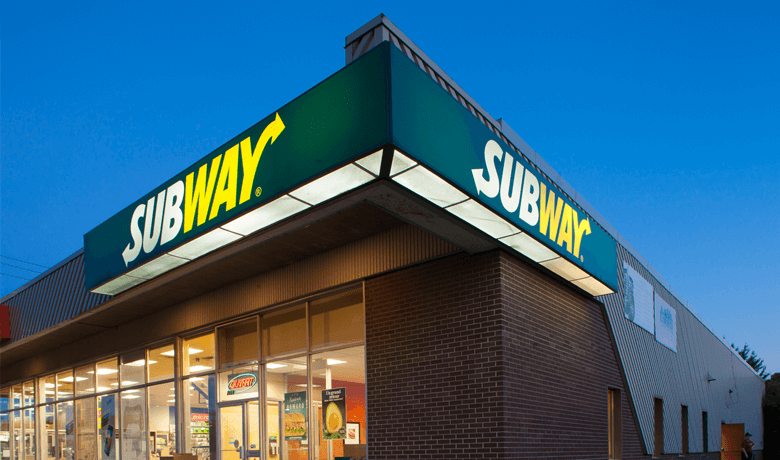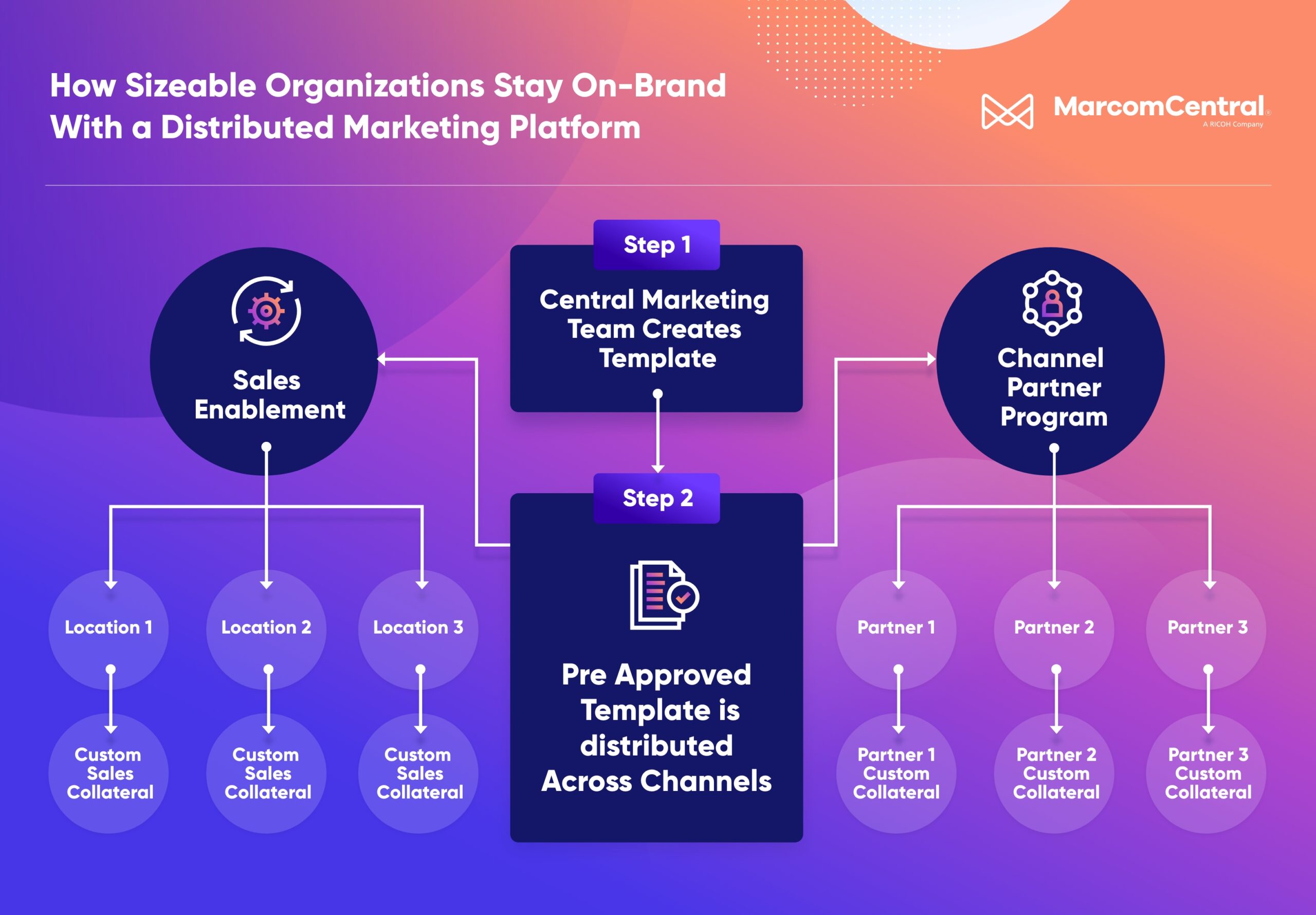Get news, updates, and insights delivered straight to your inbox.
How Sizeable Organizations Stay On-Brand With a Distributed Marketing Platform

For any large organization, consistent and effective marketing can be a serious challenge. If there are multiple stakeholders involved, each with their own priorities, the problem can be almost insurmountable without the right tool. If you want to ensure that your large organization’s marketing collateral is always on-brand, you may need a distributed marketing platform.
The Challenge of Scale
Creating marketing collateral for any large organization is no simple matter. After all, there is typically a lot of work that needs to be done. However, the problem isn’t just the quantity of work. It can also be very difficult to maintain a high quality of work. These are some of the difficulties that can come with scaling your collateral creation processes:
- Brand Compliance Issues: The key problem is that if multiple teams and stakeholders are creating marketing collateral, it is easy for people to stray out of brand compliance. Conversely, if you centralize all collateral creation, it is hard for that team to understand the needs of all the stakeholders.
- Low Repeatability: Without an effective solution, it is hard to consistently deliver great results with collateral. Even when things work out well once, it is nearly impossible to regularly repeat the success. You need guidelines and rules to make it easy for many people to create many pieces of work.
- Disruption by One-Off Projects: If you are able to make a useful, repeatable process, it will often be disrupted by one-off needs. This creates a problem that is seemingly impossible to solve: you are always either too rigid or too flexible; too centralized or not centralized enough.
These issues represent a big problem: if your organization is large, your brand may be weakened. Consistency is essential to effective branding, especially at scale. Some of the key reasons why consistency tends to fall apart within a brand include:
- Too many chefs in the kitchen- If a company is large enough and has multiple locations or franchises, each of those independent locations will most likely have many different marketers that handle brands within their local region. With a variety of marketers working for the same brand in different locations (too many chefs in the kitchen), the digital assets will most likely become off-brand or inconsistent across the business.
- Poor communication- Face it, with a corporation of hundreds of different stores and thousands of employees, communication will become very difficult. To streamline brand guidelines and messaging on this scale becomes challenging without a proper central hub.
- The company at large loses sight of the brand vision– Brands change over time. Changes in market conditions, consumer behavior, and industry developments can affect the ways in which a company operates. However, keeping up with new trends or development doesn’t necessarily require changing the brand identity as a whole. Oftentimes, when top-down leadership changes key aspects of the organization, bottom branches slowly have to adapt to these changes. In time, the organization at large may lose sight of the brand vision or the “why” that makes the company what it is today.
For all the problems that a brand faces within a company- they do make it work. For example, Apple’s marketing teams never miss a beat, even though the marketing for different products is being handled by different teams. Setting strong brand guidelines and enforcing them is the key. However, enforcement can be challenging, especially in a setting with diverse marking stakeholders. Ideally, we want to give each stakeholder the ability to give a personalized experience, without disrupting the brand that the end-user knows and loves.
The challenge of balancing control with decentralization was experienced by DaVita Kidney Care. A marketing team of just three people was responsible for the more than 2,500 dialysis centers throughout the country. This impossible amount of volume meant that field teams were simply taking matters into their own hands. Fortunately, by turning to a distributed approach, the brand was able to improve consistency and reduce turnaround times.
The Solution: A Distributed Marketing Platform
Fortunately, there is a solution to the problem of scale: a distributed approach to marketing backed by the right technology platform. This allows your organization to distribute the work to the various field teams that will be using the collateral they create while still maintaining strong, centralized controls for branding.
What Is Distributed Marketing Management?
Distributed marketing is simply a model that allows an organization to have different parts, divisions, and teams each working on their own marketing efforts. This is commonly used in franchise organizations.
For example, a national franchise pizza brand may establish a strong brand at the corporate level. However, each franchise may need to produce its own collateral to promote special deals, contact information, and more. A distributed model means that the corporate team sets brand controls but each franchisee can create their own marketing collateral.
Distributed marketing management sets the rules for this model and keeps it running smoothly. While there are low-tech tools such as brand style guides, typically the best solution for managing distributed marketing is a platform.
How Does a Distributed Marketing Platform Work?
A distributed marketing platform is a type of digital asset management software designed for the distributed marketing model. A distributed marketing platform is a tool that stores, organizes, and provides access to all the digital assets owned by a brand. For example, this includes images, presentations, videos, fonts, animations, and more.

By making the brand assets available via a distributed marketing tool, the central marketing team can ensure that all others in the organization are only creating marketing collateral with approved and compliant assets. The central team can also share templates on the platform. This makes it easy for every marketing stakeholder to create high-quality, complaint collateral.
In the example of the pizza chain, the franchisee could create a flyer with details of the latest specials by selecting the appropriate template and bringing in the relevant food images from the digital asset management system. The result is a flier that fits all the guidelines for the national brand and is easier for the franchisee to make.
You can see this idea in action with BIGGBY® COFFEE. This coffee brand empowered more than 200 franchisees with on-demand access to marketing content through its Marcom distributed marketing platform.
How Can You Ensure Brand Consistency and Compliance With a Distributed Model?
With the right platform, you can empower marketing in your distributed model. The key to ensuring brand consistency is to have distributed marketing management software that can handle everything needed for brand compliance. This should include fonts, templates, images, and other assets. Your distributed marketing platform should be a one-stop-shop for anyone who needs to create marketing collateral in your organization.
The benefits of getting this right are significant. You can enjoy the brand consistency and power of a fully centralized strategy while also having the insight and on-the-ground abilities of your field teams. In some organizations, such as franchise businesses, a distributed model is the only viable option.
How To Implement Your Distributed Marketing Software
Of course, getting started with distributed marketing is not as simple as picking a platform and leaving it to run itself. The following are a few tips to help with achieving distributed marketing success:
- Define Success for the Strategy: Like any other business initiative, distributed marketing needs goals. Define the benefits of using a marketing platform for your brand.
- Develop Training for Users: Create materials to train platform users. This should cover technical aspects of the platform as well as brand compliance rules.
- Actively Manage Marketing: While your central marketing team does not need to handle all collateral creation, it should actively manage the assets and periodically check on collateral for consistency.
- Set Clear Brand Standards: Having a strong brand style guide will help you to ensure superior results. Your distributed marketing should be supplemented with clear instructions on how to use assets.
- Ensure Appropriate Access: If users don’t have access to the assets they need, they will work around the platform. Ensuring proper access is essential.
Many of these techniques were applied by the Boys and Girls Clubs of America when it rolled out its marketing platform. With more than 4,100 local affiliates, BGCA needed to be able to both control users in a distributed marketing model and give them the freedom to create. By leveraging the full power of MarcomCentral, BGCA was able to significantly reduce brand inconsistencies and provide resources and support to an extensive network of stakeholders.
Harness the Power of Distributed Marketing Management Software
For many large organizations, a distributed marketing model is the only way to create enough marketing collateral that is sufficiently localized for the needs of stakeholders. However, ensuring consistency in such a model can be difficult. Fortunately, with the right distributed marketing platform, you can have your cake and eat it too. MarcomPortal is a powerful digital asset management tool designed specifically for distributed marketing. Learn how you can easily customize and distribute marketing assets that are 100% brand compliant from anywhere in the world with our distributed marketing platform
You might also like


